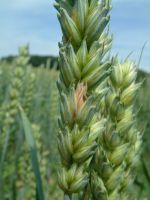Fusarium spp.
Fusarium spp.
Damage symptoms

A typical symptom of ear fusariosis is the bleaching of individual spikelets after infection has occurred. Subsequently, the infected spikelets die and the fungus continues to grow into the ear rachis. Due to the interruption of the nutrient supply, the entire upper part of the ear usually dies. The result is whitish to reddish discolored caraway kernels. In damp weather, a pink to salmon-colored spore coating also appears on the infected spikelets.
Propagation and transmission
Infection usually originates from crop residues in the soil, on which the fungus survives. However, Fusarium can also be transmitted via the seed. This seed infection is mainly responsible for emergence damage. Leaf and ear infestations are caused by spores (ascospores or conidiospores) spread by wind and rain splash. If the spores get onto the ear, they form a dense fungal network (mycelium) on the inside of the glumes and on the ovary.
Favorable infection conditions prevail in humid weather during grain flowering. After successful infection, the formation of toxins facilitates further penetration of the fungus by inhibiting the plant's defense response.
Economic importance
Fusarium plays an important role in cereal production throughout the entire growing season. Beginning with the death of the seedling due to Fusarium emergence damage, roots, culms and leaves can also be affected. The greatest importance is attached to infestation of the ear plants, since in addition to yield reduction, the fungal toxins (mycotoxins) formed mean a considerable reduction in quality.
Prevention and control
- Crop rotation planning: Tight corn-cereal rotations increase the risk considerably.
- Select varieties with low susceptibility
- Eliminate crop residues by turning the soil (especially if corn is the previous crop).
- Direct control of ear fusariosis with fungicides (seelist of plant protection products approved in Austria) is only possible immediately before or after infection. The effectiveness of such measures is therefore limited
Specialized information
Publications
Oberforster, M., Plank, M., 2020. protecting wheat, durum and triticale from ear fusarium. The Plant Doctor, 5, 8-10.
Felder, H., 2015. corn: cob rot grading should reduce fusarium. Der Pflanzenarzt, 68(1-2), 32-33.
Mechtler, K., Reiter, E., Lemmens, M.; Kuchling, S., Felder, H., 2014. occurrence of Fusarium fungi and mycotoxins in grain maize in Austria. Mitt. Ges. Pflanzenbauwiss, 26, 46-47.
Zederbauer, R., Besenhofer, G., Plank, M., 2001. On fungicide use against ear fusariosis with special reference to durum wheat. Pflanzenschutz, 17(2), Federal Office and Research Center for Agriculture, Vienna, 1-4.
Last updated: 08.08.2024
automatically translated